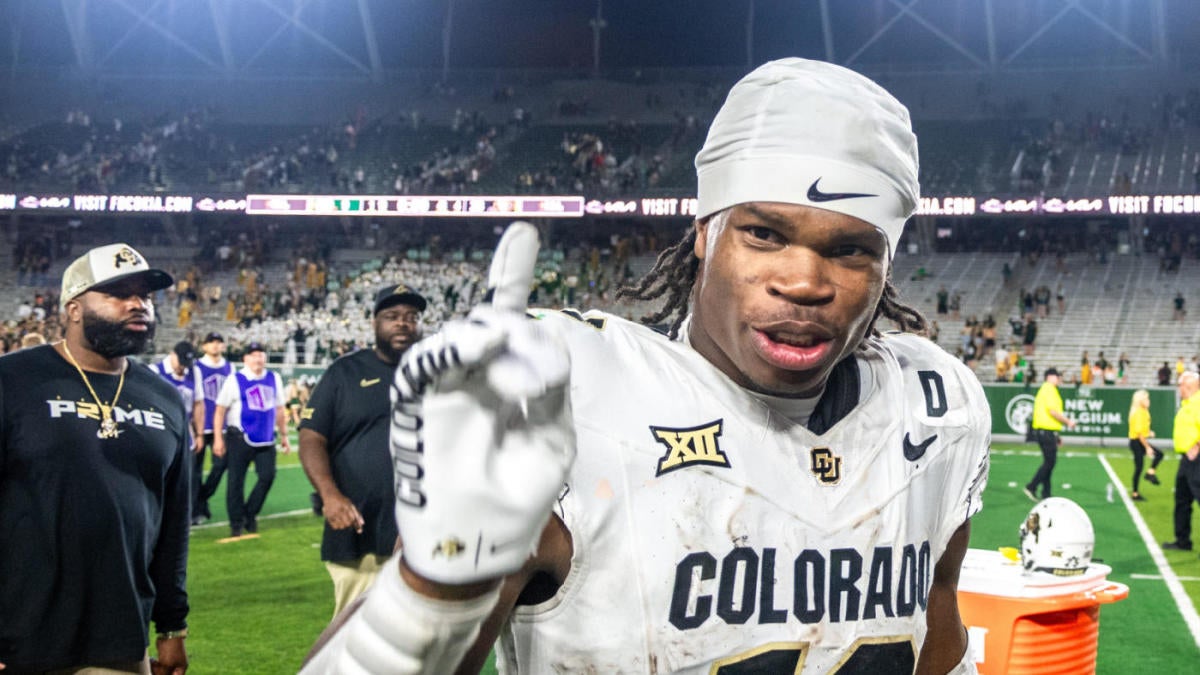
It makes all the difference in the world to actually be at games.
I’ve been to approximately 250 games during my time at CBS Sports alone. It hit me again Saturday night, watching Colorado’s fantastic Travis Hunter. You have to see this guy in person to fully appreciate his talents. He goes both ways, including special teams, routinely playing 100-plus snaps.
The dude never slows down. That makes him not only a Heisman candidate but a marvel of modern science. When you’re actually at the game, you see things like Hunter taking himself out of the game. All it took was Hunter running down a Colorado State player from behind after a 62-yard run.
“I got mad at him for getting out of the game, too,” quarterback Shedeur Sanders said jokingly. “I said, ‘Bro, don’t ever do that again.'”
As the Colorado State game wound down Saturday, I tried to find Hunter on the CU bench. I couldn’t. He was still in the game, catching passes from Shedeur Sanders in the final minute.
All of it got me thinking: Who are the best players I’ve seen in person? Not the best of all time or even the best in a season. The best I’ve seen. Hunter is on my top-10 list after sifting through the cobwebs of my mind. Yes, he’s only been at Colorado for less than two years, but Hunter truly is a unicorn.
He is joined on this list by some obvious choices (Tim Tebow, Reggie Bush). There is one player on the list (Kellen Winslow) who played in the 1970s. OK, make all your old-guy jokes. I live to serve.
Here’s my list of the top 10 players I’ve seen in person.
1. Barry Sanders, RB, Oklahoma State
Best college player I ever saw. No question. Hands down. You’re not surprised. Sanders could do things on two legs that elite thoroughbreds couldn’t do on four. I was just lucky enough to see him in person. As a pup at the Kansas City Star in 1988, I was assigned to an Oklahoma State game at Nebraska. The contest has been recorded as a decisive 63-42 Huskers win. Nebraska was ahead 35-0 after a quarter, 42-0 four minutes into the second quarter. But the takeaway was Sanders running for 189 yards and three touchdowns. At the time, that was the fourth-largest rushing total ever against Nebraska. The 42 points were the most scored against a Tom Osborne team to that point. Sanders did it on the road against Nebraska, which was still a national program.
In a foreshadowing of a Heisman season, Sanders stepped around and outran elite defenders. That was in the middle of Sanders running for a single-season record 2,358 yards. The record is now 36 years old and seems like it will never be broken. To put it in perspective, 95 teams didn’t run for that many yards last season.
2. Travis Hunter, WR/DB, Colorado
On the road Saturday at altitude at Colorado State, Hunter played 123 of 138 snaps. Before Hunter’s arrival in 2023, the CU record for most snaps in a game was 114, set by four different players (all offense) against UCLA in 2015. Saturday also qualified as a career game, positioning Hunter squarely in the Heisman race. His 13 receptions tied a career high. Hunter scored twice, adding an interception and five tackles. In 12 career games, Hunter has averaged more than 124 plays per game. Hunter is second nationally in catches (30) and tied for second in touchdown catches (five).
In his Colorado debut last season against TCU, he was on the field for 146 snaps, contributing with 11 receptions and an interception. We are witnessing history. If he holds up, this will be Hunter’s first full season. He missed four games in 2022 at Jackson State and a few at Colorado last season after suffering a lacerated liver against Colorado State.
“There’s no question he can be even better,” coach Deion Sanders said. “There’s no ceiling.”
3. Tim Tebow, QB, Florida
My first interaction with Tebow was in USC’s locker room after a game. Huh? Yep! He was on his official visit, and the Trojans had gone all in to try to land the next great one. Back then, locker rooms were open to the media. I could see Tebow’s wide-open eyes drinking in the celebration. Florida would land him, of course. The kid was a Gator through and through. Homeschooled and homegrown.
From the time he threw that first jump pass against LSU in 2006 to his hand in two national championships, Tebow became one of the most beloved Gators of all time. His Heisman statue outside The Swamp proves it. In his career, Tebow went 48-7 as a starter and played for two SEC titles. Tebow’s arrival coincided with the SEC’s domination of the sport. That ’06 Florida championship kicked off a run of 13 SEC national titles in the last 17 years. Tebow wore his passion like a jersey.
We’ll always remember those crocodile tears after losing to Alabama in the 2009 SEC Championship Game. In Urban Meyer’s offense, which contained all sorts of Single Wing principles, Tebow was basically a fullback who could throw. Even the ultra-tough SEC couldn’t stop him. Florida has been chasing that magic ever since.
4. Ndamukong Suh, DT, Nebraska
Defensive tackle is one of the hardest positions to recruit. There just aren’t a lot of 6-foot-4, 300-pound guys with a high motor who want to butt heads all day. There are even fewer who dominate at that position.
It’s almost forgotten that Suh might have been the defensive player closest to winning the Heisman since Charles Woodson. He was one of the most decorated college players in history, becoming player of the year (Associated Press), defensive player of the year (twice, Bednarik and Nagurski), best down lineman (Lombardi), best interior lineman (Outland) and a unanimous All-American.
Suh was named to the NFL’s all-decade team of the 2010s. He was simply the most athletic interior lineman of the modern age. Suh was listed as a defensive tackle, but he played up and down the line at Nebraska. In his final season (2009), Suh had a career year with 85 tackles — incredible for a defensive tackle — 12 sacks and 20.5 tackles for loss.
In a 13-year pro career, Suh was a three-time All-Pro, a rookie of the year (2010) and a Super Bowl champion (Tampa Bay, 2021). His father is a native of Cameroon. In that country’s native language, Ndamukong means “House of Spears.” Ask any opponent. That seems about right.
5. Reggie Bush, RB, USC
For most of that first decade of the century, the Trojans not only owned college football, they owned L.A. There is a distinction. There was a moment after a win over Notre Dame at the Coliseum one year when it hit Matt Leinart. He looked around at the scene, the adoration, the future. Life couldn’t have been better. You could see it in his eyes. He and Bush owned the town. They helped transform an inconsistent program into a world-beater in the Pete Carroll years.
Bush was a much-coveted running back from San Diego who was part of Carroll’s secret sauce. Yes, the Trojans were flashy, but they won because they were SEC-level tough — in the trenches, in the backfield. Bush might have been the tip of the spear of that resurgence. His moves caused opponents to reach for the Dramamine. But he could also put his head down. That’s why we’ll always be asking why he wasn’t in there for 4th-and-2 against Texas in the 2006 BCS National Championship Game. LenDale White, weighing 250 pounds, was in the game and was stuffed. That essentially ended the USC dynasty. Being modest here, but my oral history of that game helps sum it up. I’ll always remember getting to my hotel late one night after a game (maybe at Michigan State) and catching Bush’s signature move in a game against Fresno State. In that 50-42 win, Bush accounted for 378 total yards (a school-record 294 yards rushing).
Bush dominated much of the next decade in another way as his old running backs coach, Todd McNair, was unfairly pursued by the NCAA. Bush himself had his Heisman taken away (since returned) after that NCAA investigation. Bush’s pursuit has changed to protecting his legacy from the NCAA. He continues to sue the association for defamation. His football accomplishments will outlive the paper trail.
6. Cam Newton, QB, Auburn
Newton had it all — arm, legs, explosiveness, charisma, NCAA investigators breathing down his neck, and a dad (allegedly) with his hand out. While Cam’s talents exposed defenses during a 2010 Heisman season, his recruitment was exposed as something less savory. Newton fell afoul of the NCAA when reports surfaced that his dad Cecil had asked Mississippi State for $180,000 for his son’s talents in recruiting. Oh, the outrage. That number would be an insult by today’s NIL standards for a five-star talent.
Back then, while Newton’s smile lit up a room and his arm scorched secondaries, the dude had baggage. By baggage, he needed a Four Seasons bellboy to carry it. Newton is on this list because of his talents. That arm — I don’t know if I’ve ever seen a rocket like that. The Heisman voters certainly didn’t care that year. This would be the ultimate feel-good story if it weren’t for all the extra work he caused us hacks back in the day. The alleged wrongdoing was so unique that no one could imagine a rule would have to be created designating parents as boosters if they solicited funds for their son’s talents. That’s how the “Cecil Newton rule” was created. In that sense, Cam not only rewrote the record books but also the NCAA rulebook.
I choose to remember the Cam Newton who won the Heisman in a landslide. Oregon defensive coordinator Nick Aliotti said before the BCS National Championship Game that half his defense was smaller than Newton. I won’t forget that Cecil Newton didn’t attend his son’s Heisman ceremony. He didn’t want to be a “distraction.”
7. Brian Bosworth, LB, Oklahoma
Getty
Like a lot of players on this list, Bosworth created his own atmosphere. For all the flash and controversy he created, the dude could absolutely play. He was physically intimidating on and off the field.
I remember visiting his dorm room in the mid-1980s when such things were still possible for the media to get a good feature story. The kid from Plano, Texas, was like half of my dorm-rat friends in college — just there to drink a few beers and hang out. Except this guy also had an entire university on his back, chasing a national championship. We all watched as Brian Bosworth transformed into “The Boz.” The on-field version could run down a herd of gazelles. Those Oklahoma teams were so powerful that I once witnessed Boz and quarterback Jamelle Holieway take their pads off at halftime at Kansas State and eat hot dogs while conversing with fans. In the theater of the absurd, Boz was suspended for a positive drug test and wore an “NCAA” shirt on the sidelines at the Orange Bowl that declared it was the “National Communists Against Athletes.”
Yeah, he was immature. But we all grow up. Bosworth legitimately cried when I interviewed him upon his entry into the College Football Hall of Fame. “That’s really what the College Football Hall of Fame is looking for,” Bosworth said. “They want quality character. They want human beings with passion.”
Dr. Pepper absolutely knew where to go when the Fansville campaign was created. In what will remain a career highlight for me, a couple of years ago I was trying to track down Oklahoma AD Joe Castiglione at halftime in his suite at a game at Kansas State. When I arrived, the only person in the suite was Boz. “Hi, Dennis,” he said. It had been a long time since the mid-1980s.
8. Ed Reed, S, Miami
Getty
All-American. Hall of Famer. Ballbuster. Fashion plate. Dude honcho. Some player or another from Miami had to make this list. Reed happens to be my guy because he is a walking, talking example of Miami talent, swag, drip, leadership and style. When Reed showed up for his College Football Hall of Fame induction a few years ago, I wanted to interview his suit. He was so happy and so grateful that night. Former coach Manny Diaz hired Reed as chief of staff in 2020. His expertise as a talent evaluator and ambassador was valued.
At the end of the last great Miami run, the amount of talent in one place was staggering. In 2002, Miami and Ohio State combined for more than 40 future NFL draft choices in that season’s BCS National Championship Game. That was the year after Reed left. He was the leader of a defense and a team just coming out of crippling NCAA probation. In his 2001 senior year, Miami led the country with 45 turnovers. Reed’s nine interceptions also led the country. Two of them came against Virginia Tech. Three of the picks went for touchdowns. In back-to-back seasons against West Virginia, Reed had 15 total tackles (1998) and 12 solo tackles (1999). His pro career speaks for itself.
In 2020, I was all lined up for a sit-down offseason interview on camera with Reed. COVID-19 hit, and I never got to do the interview. If there is a disagreement with this pick, you’ll have to go through Sean Taylor, Michael Irvin, Bernie Kosar, Warren Sapp and Russell Maryland before getting to me. All of those Hurricane greats are deserving. Reed just happens to be my pick.
9. Tyrann Mathieu, DB, LSU
This one is easy. The Honey Badger was the best player I saw who ever got kicked off a team. Those were momentary failings. While still at LSU, he could have won a Heisman. Maybe he should have. In 2011, he was invited to New York and finished fifth in the voting. That same year, Honey Badger was also the national defensive player of the year. Not since Charles Woodson had there been a defensive back like him. The LSU cornerback’s ability was so ubiquitous he could control a game from his spot in the defensive backfield.
Offensive coordinators avoided him, but they couldn’t shake him. Mathieu could line up anywhere and dominate. I finally gave up trying to describe his talents and created a new stat that included his tackles, interceptions, forced fumbles and fumble recoveries. I remember visiting his New Orleans high school, the legendary St. Augustine in the Seventh Ward. Mathieu had been the living symbol of the city’s everyday struggle. For a time, St. Aug’s practice field was a city park with no goalposts. Locals watching practice would warn players to duck when they heard gunshots.
As a pro, Mathieu has been a champion (Kansas City, 2019), a community leader and is headed toward the halls of fame — plural — both college and pro.
10. Kellen Winslow, TE, Missouri
The indelible image burned into my memory is of Winslow hunched over an Associated Press ticker in the Columbia Missourian newsroom. That’s how Winslow found out he’d been drafted No. 13 overall in 1979 by the Chargers. No television. No draft party. No hype.
Winslow went on to become a part of the transformative Air Coryell offense in San Diego. Back then, folks didn’t throw to the tight end, at least in college. (St. Louis Cardinals tight end Jackie Smith was Winslow’s precursor.) Winslow caught 71 passes in his four-year career.
It used to bother me that coach Warren Powers didn’t use him more. But Winslow was also a valued blocker who was responsible for some of the biggest moments in program history. (Full disclosure: I’m a Missouri grad.) Winslow proved that tight ends could be difference-makers in the modern era. Go back and find film of Winslow in the 1982 AFC divisional playoff game at Miami.
In one of the greatest performances in NFL history, Winslow caught a then-playoff-record 13 passes and blocked a field goal. An iconic picture of an exhausted Winslow being helped off the field is NFL lore. “I’ve never felt so close to death before,” he said.
Without Winslow, there is no Rob Gronkowski. Without Gronk, there is no Travis Kelce.

Must See
-


Football
/ 2 months agoHuskers Fight Hard but Fall Short Against UCLA
LINCOLN – The Nebraska Cornhuskers gave it their all on Saturday, with standout efforts...
-
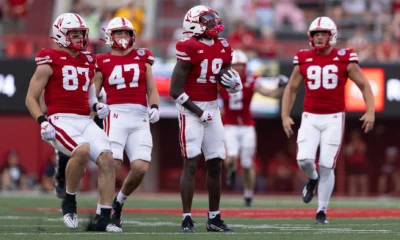

Football
/ 3 months agoGAMEDAY: Nebraska Set to Face Undefeated Indiana in Key Big Ten Showdown
Bloomington, IN – It’s Game Day, Husker Nation! Nebraska (5-1, 2-1 Big Ten) returns...
-


Football
/ 3 months agoBlackshirts Shine as Nebraska Tops Rutgers 14-7 on Homecoming
Lincoln, NE – Nebraska’s Blackshirt defense played a starring role in the Huskers’ 14-7...
By Chris
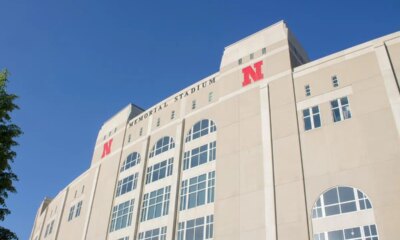

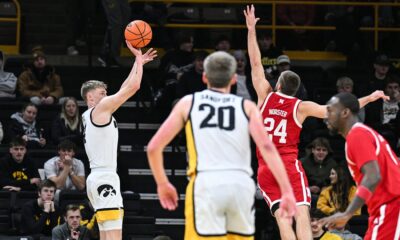

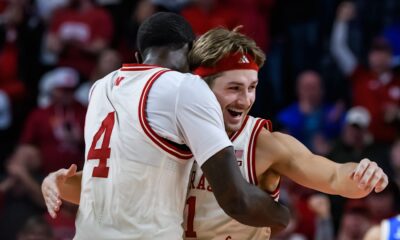

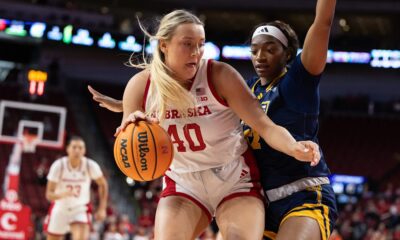

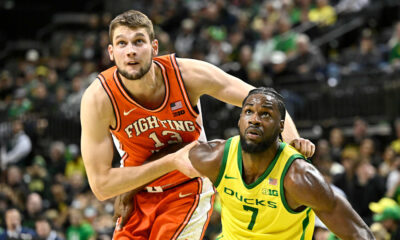



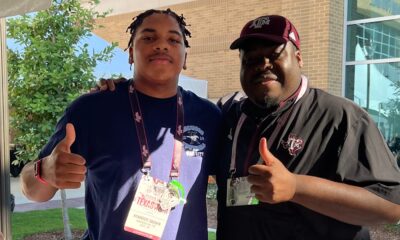





You must be logged in to post a comment Login